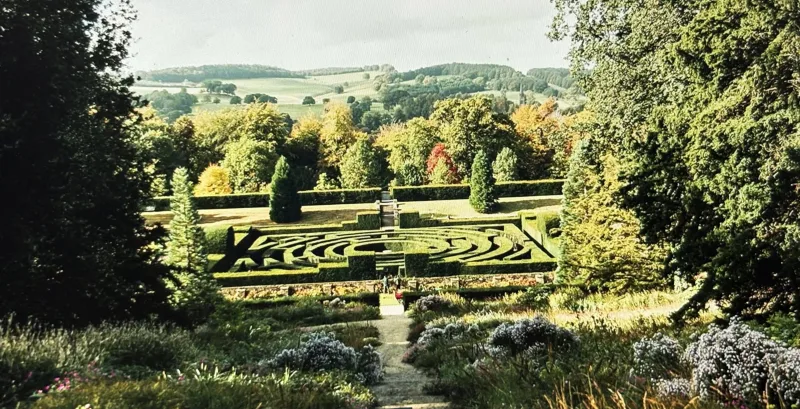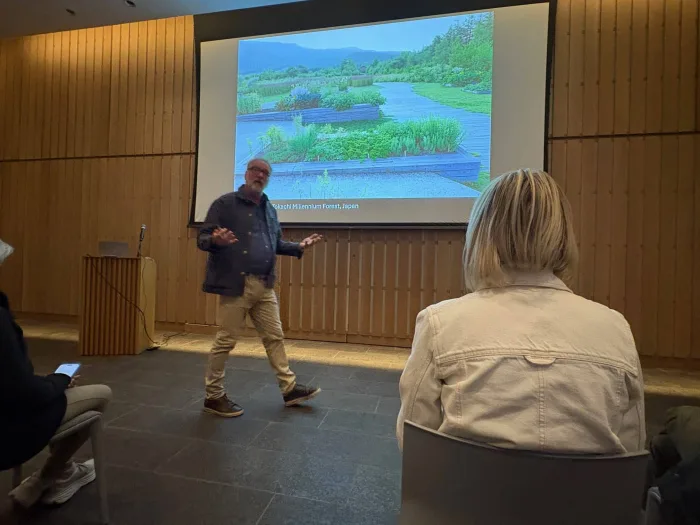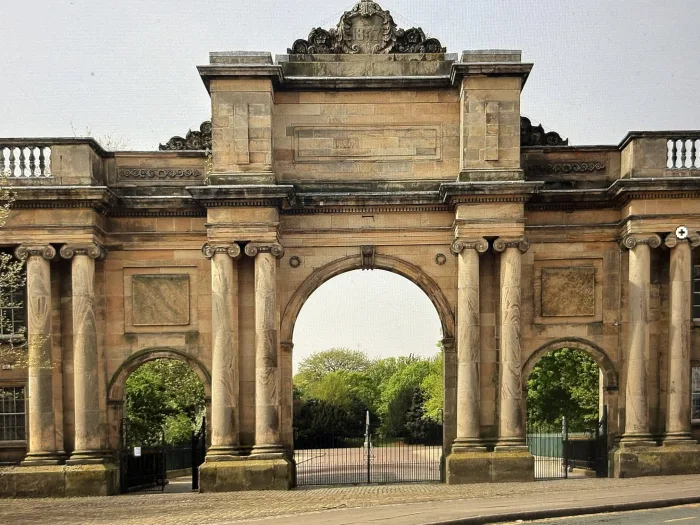
By Anne W. Semmes
Just how the English garden design has changed across the centuries to what it is destined to be in this 21st century was well laid out by noted English landscape architect, garden designer and author Richard Sneesby, at the Bruce Museum’s last Saturday “Meet for Coffee” talk, attended by 65 garden enthusiasts. “My passport says…my nationality is British,” Sneesby began, but he identifies “most of all as being English…for I’m talking about English gardens as opposed to Scottish or Welsh or those from Northern Ireland.” And beginning with William the Conqueror’s arrival in 1066, England “had no gardens at all…we were growing food as was happening in northern Europe.”
Start with those English gardens beginning in the Tudor period in the 15th century with Haddon Hall in Derbyshire. “We get this classic sort of ‘not very formal geometric arrangement’ principally still growing food and combining with culinary and medicinal herbs.” But then those 17th century Versailles Palace large-scale gardens had an impact. “We were bringing in some of the French ideas,” he told, and “We were starting to become interested in a romanticized view of the landscape coming through art and paintings… and the people getting involved were gardeners. They weren’t architects and they weren’t engineers. They had grown up through apprenticeships, learning about gardens, living in gardens.”
And with that romanticized view came “classical references and Palladian follies and grottoes and lakes and bridges and things… So that when the people would walk around these gardens,” he noted, “they could be educated about the classical mythology.” Then came that landscape designer William Kent in the 18th century with his ideas for the historic Chatsworth House in the Derbyshire Dales, enlisting Capability Brown to create “those English landscape parklands that we’re familiar with.” And importantly, “This is not happening anywhere else. This is English. We’re not copying anymore; we’re finding our own identity.”
The birth of the English parklands
But then came the industrial revolution. “Everyone is moving from the countryside into the towns,” described Sneesby. “And we start to see people getting interested in improving the lives of the people who live in those miserable, sprawling urban colonies.” Enter gardener Joseph Paxton, “who starts to build a number of these parks,” such as Birkenhead Park in northwest England. “And this is important to you guys… one of the people from Connecticut, Frederick Law Olmstead goes to Birkenhead Park, likes what he sees and thinks I can do that back home. He adapts Birkenhead Park into what became Central Park.”
By the end of the 19th century he told, “We’re in Downton Abbey territory…Edwardian England. We have people working in the houses, on the land, creating gardens, growing crops… big communities serving the estate…until we get the First World War and most of the men are killed. So, we now have no gardeners anymore… this is where the English garden story really starts.
Also arriving at the end of the 19th century in England is the arts and crafts movement. “We have a group of intellectuals not very keen on the industrial revolution,” told Sneesby. “They like more traditional building materials… So, we have architects designing houses that are very specific to the locality. In the Cotswolds’ which sits on limestone, they’ll be made of stone. If we’re in outside London and the southeast which is built on clay, they’ll be made of brick with clay roofs. There’s a lot of timber, a lot of furniture, and ceramics, and textiles, and all sorts of wallpapers and things.”
Houses are being built “on a slightly smaller scale than the big, landed gentry estates. We start to think about the gardens that might accompany those houses.” Enter horticulturalist Gertrude Jekyll “pioneering the idea of using flowers and plants for a kind of aesthetic appeal…heavily influenced by what was going on in impressionist art.”

Arrival of the arts and crafts gardens
These smaller gardens he told “didn’t need gardeners… So, we end up with these classic arts and crafts gardens of England… No one else was doing this in the world. And not only were we doing it, but we were better at it than anyone else. We’d invented it ourselves and people started to copy us… And we have these famous gardens.” Such as the “iconic” Munsted Wood house in Surrey, home of garden designer Gertrude Jekyll, designed by her friend and “most important architect at the time Edwin Lutyens.”
But now with climate change there are changes coming to those English gardens. Sneesby mentions his book “The Color Companion” addressing “combining plants in color theory” and “identifying a country with a color. And spoiler alert, England is green…We’re incredibly good at growing grass, and we have lots of trees.” But of those 400,000 trees Sneesby has reportedly planted over the years, “most of them, oaks and ash and larch are going to be dead unfortunately…And we need to be planting 400,000 trees that no one is growing.”
The need for greenspace gardens in cities
“We’re having to start to think as garden designers about other opportunities to create greenspace cities and open space in cities there’s not an awful lot of.” He showed an image of the Battersea Power Station in London. “It has been redeveloped as exclusive apartments…with a greenspace on the roof.” So instead of our roofs being made of slate or zinc or tin, they can be green rooms. The landscapes can be meadows, we can have wildlife ponds, we can retain the water.” And with the 60 percent of insect loss in 20 years he told, “We have people developing pollinator projects…Instead of having pansies and geraniums and hollyhocks we can plant perennial pollinators that don’t need gardening. We’re seeing quite a lot of this going on in domestic gardens in the UK.”
Sneesby would end with an ongoing landscape project in Dorset he has been at work on for 20 years with his wife Henrietta, also a landscape architect, and present at the talk. He cited it as “a combination of Capability Brown and Arts and Crafts. “So, the house is newly built in 2006 with a dairy farm, so we dug up the soil and flipped it over…If you plant on topsoil, you don’t get a meadow, you get thistles and weeds.”
Within a year, he continued, “Everything had come back, the butterflies…The second thing we did, and this is very close to being Capability Brown, we built a lake…about four acres…designed specifically to have an extremely wide range of ecological habitats. So, it had shallow water, deep water, deadwood, beaches, island…And a few years later, it looks like it’s been there forever.” He added, “The courtyard in the center of the house is essentially an arts and crafts garden. We’ve got the architectural response, we’ve got the hedges, we’ve got the planting, we’ve got the lawn. It doesn’t pop up in Google in the quintessential English gardens – it probably should have done.”
But also impressively on Sneesby’s project desk is an elderly care village in southern England he’d like to address at the Bruce five years hence. “It’s going to house about 300 people. It’s got an inpatient unit, so it’s a hospice essentially, which means that people go there to die.”
And behind that unit is an assisted living accommodation for 55 plus couples. “If you are in a couple and one person starts to develop a progressive illness and the other person is healthy…there’s constant care going on in a dignified way. So, it’s an exciting project in terms of all the things I’ve talked about.”





